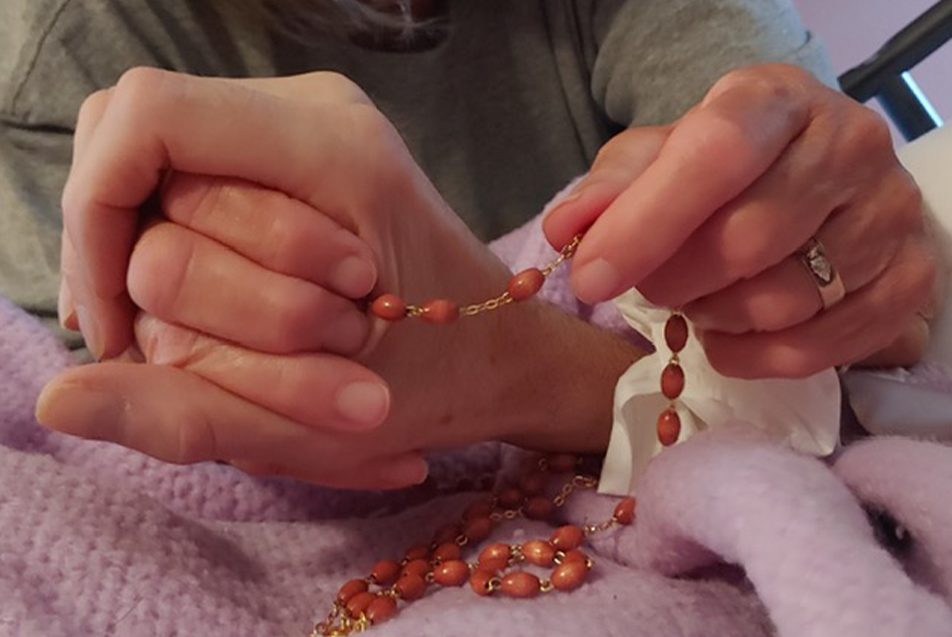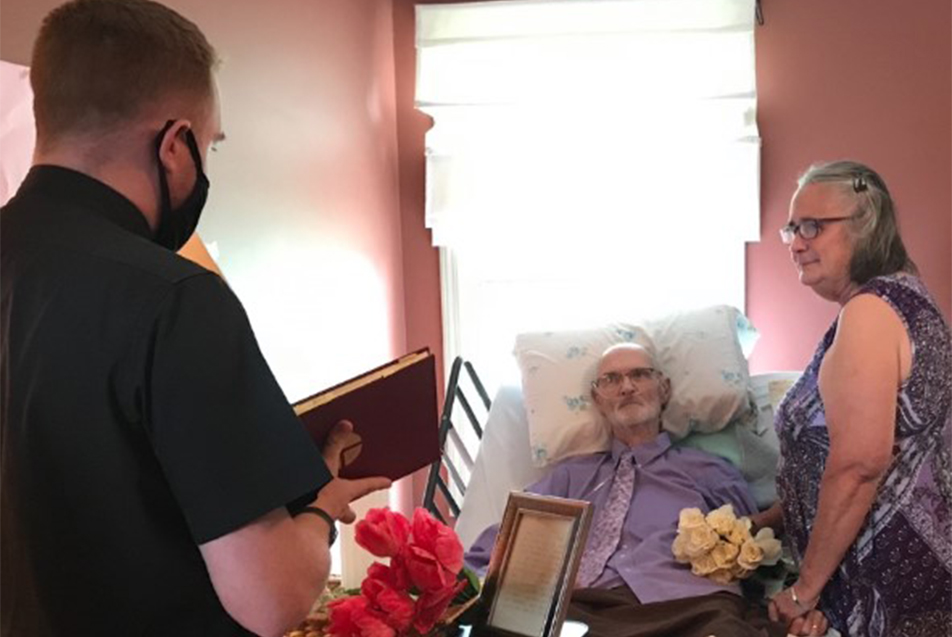
Oftentimes, families are faced with difficult decisions regarding health care and what is the most prudent decision for a family member. Journeying down such a path has obstacles, uncertainties, pain, doubt and fear. Reliance on personal faith, love of the family member and understanding that there is no “right way” to make these decisions are the initial steps. Fortunately, hospice care can become the stabilizing factor in such situations. This was the case for John Sandor and his family. Join John’s wife, Jane, and their daughters Stacy, Kim and Lindsay as they recount and reflect on John’s journey in hospice care that ended on September 9, 2020.
John’s previous health issues, including a triple bypass surgery in March 1997, necessitated regular cardiac care under the direction of Roy Robertson, MD, PPG - Cardiology, and Jessica Barkdull, NP, PPG - Cardiology. During a routine visit to their office, it was determined that John needed a referral to a pulmonologist. The pulmonologist’s final diagnosis in March 2018 was idiopathic pulmonary fibrosis (IPF), a scarring of the lungs from an unknown cause, which greatly diminishes lung capacity, resulting in other physical limitations.
From June 2020 until September 9, 2020, we traveled the uncharted course of living with IPF and its horrendous effects on the patient and family. Support and dependence on one another, fully knowing that no one was sure what the next step might be, were our guideposts.
Parkview Home Health became part of John’s “family” of caregivers. Our daughter Kim recounted that an essential part of her dad’s home health care was the goals and objectives that he and his healthcare team set regarding mobility and function. Unfortunately, his health continued to decline and we realized another course of action was needed – a move from rehabilitation and improvement to maintaining his quality of life. “Dad was afraid of progressing to the end-of-life stage,” Kim said. Hearing the word “hospice” conjured frightening thoughts.
Then, by late July, there was a marked decline in John’s health. Through earnest and honest conversations, the Home Health personnel, Kim, Emily, Ben and hospice nurse Dawn, reassured John that hospice did not mean death was imminent. Instead, it meant that John and our family would be able to prepare as we moved toward that stage. Hospice would provide a different and more appropriate level of care for him regarding access to medications and skilled nursing care.
August 18 was the day that our family’s life began this final chapter. I clearly remember every detail of that day and the decisions that we made. Lorie Lucas, John’s case manager and primary nurse, visited. With specific details enveloped with great compassion, Lorie explained what her care plan would be and how it would help John. She assured us that quality of life would be maintained and protected. John asked me what I thought he should do. “It is your decision, and I will support you no matter what. God’s hand is in all of this, and he only asks that we hold on.” Those were the words I said to John as we decided to begin hospice care. It’s important to understand that it truly is a WE decision: patient, family and medical personnel. A united effort is crucial for a positive and successful hospice experience.
Our other daughter, Stacy, shared that she didn’t know what she was hoping for with hospice, but in retrospect, she realized that hospice gave us family-centered care. “Lorie Lucas is a great example. She made sure she knew our names. She always talked with us, got in on our inside jokes and silliness. That was the gift of hospice for us. The love and support of the family were everything to Dad. A nurse cannot administer that on her own. She may have medications to keep him comfortable, but I honestly believe that Dad would have passed away sooner had he not been at home, and we wouldn’t have been there. It was a blessing to walk with Dad to the threshold where he crosses, and we stay behind for now. It was a gift and an honor to be part of Dad’s journey,” Stacy said.
For our other daughter Lindsay, it was important to her, John and the entire family to play and listen to music while incorporating the things he loved most into the space. This enabled all of us to have a unique and personal experience during this end-of-life stage. “Dad had a song for everything and a memory to go with each one. We made sure that his room was always full of family: daughters, sons-in-law, grandkids, even his favorite cat, Milo and our dog, Bentley. Hand-drawn pictures from the grandkids were everywhere. We made sure his room reflected his taste and what held great importance for him,” Lindsay explained.
“Dad also loved having company. We were so blessed that his only sister and all seven of my Mom’s brothers and sisters and their spouses were able to visit with Dad the last few days of his life. He was alert and had great conversations with them,” Lindsay remembered.
Stacy was also grateful that her Dad’s sister came and brought things from his childhood and his time of service in Korea. It was important to move artwork and pictures so that they were in John’s line of vision. They were great focal points for him. Once John moved to a hospital bed, we made sure to transfer several of his favorite things, like his tape recorder, so they were close to him. We knew he wouldn’t be using them, but they were important to him, and we needed to provide a sense of normalcy for both him and us.
As John’s wife of forty-five years, my ultimate goal was to maintain his dignity to the very end, no matter what. We would do whatever was required. Sunday, September 6, was a memorable time for all of us. Prior to that day, Friday, September 4, John began to show a rapid decline. So, I contacted Lorie, and she came right over. I also called our daughters and told them they needed to head home because Dad was not doing well. I also reminded John that our 45th anniversary was only two days away. John promised he would be here. True to the man he was, he kept his word.
Stacy, Kim and Lindsay arranged for one of our parish priests to come Sunday afternoon. Our entire family, daughters, sons-in-law, grandchildren, cat and dog gathered in the bedroom. The girls’ spouses and the two oldest grandsons helped groom John’s beard, cut his hair, dress him in a dress shirt and tied his tie. They helped prepare the groom for his wedding day forty-five years later. Father Jay Horning led us in prayers and blessed our wedding rings. As husband and wife, John and I repeated the same wedding vows we said many years ago while the music from our wedding day played in the background. This was truly a celebration of life.

John continued to decline. On Monday evening, September 7, our family prayed our last rosary together while listening to the rosary recording that John used during difficult times. Through faith, the love of family, and the choice to embrace hospice, I believe that John’s dignity was maintained, and we were able to celebrate the gift of him, our family and our life together.
Remembering the time
In looking back on the entire hospice experience, we all had different thoughts on John’s comfort level and quality of life:
“Hospice helped maintain a sense of normalcy and made him feel like he was still our Dad. We chose not to shield ourselves but instead stayed close to him. One of us was always holding his hand, lying next to him or sitting close to him. We made sure that he could feel us there with him, no matter what. We maintained that closeness and togetherness with him,” Lindsay said.
“On a practical level, we had honest conversations with the hospice nurses about medications. Whenever we had a question, we would call hospice, and someone would be quick to help us with the correct information. Even on the weekends or in the middle of the night, the nurses helped us understand what to do. If Dad was hurting, they would let us know which medication would help. I think those talks were a big part of his comfort level because those were things we couldn’t offer him, but they could,” Stacy shared.
For me, physical touch was vital. We would crawl into the hospital bed and lay next to John or push the king-size bed next to the hospital bed and just pile in. John needed that affection. He was a cuddler, loved hugs and being close to people. I think us being there helped him find comfort. He would always say, “It’s going to be okay.” The day before he passed, he said everyone was here and happy. I know it sounds like we gave him a lot, but he gave us more. We are so grateful for this sacred time in this sacred space: our home.
Reflecting on the decision
Another aspect of hospice is understanding how one’s perspective on end-of-life conversations and preparing for that last chapter can only be realized once death has occurred. These were the thoughts we all had:
“After this experience, I cannot imagine a loved one dying in a hospital instead of at home. If you’re fortunate to have the option as a loved one approaches end-of-life, do it. I can’t imagine being anywhere but home,” Kim shared.
“It was an absolute gift to be with a loved one as they cross the threshold. I wouldn’t want it any other way,” Stacy said.
“It was a gift to be with Dad and for my children to be with their Grandpa,” Lindsay recalled.
Offering advice
If other families are facing a similar situation, Stacy, Kim and Lindsay had a few things they wanted to say, offering some guidance and advice based on their experience:
“Just be there. Hold hands, laugh together, remember the special times and always say I love you,” Lindsay suggested.
“You don’t have to have it all sorted out. You don’t have to get everything right. You have to figure out how to embrace it. Take everything as it comes and just be yourself,” Kim advised.
“It’s important to take care of yourself and one another. Know your support people. As silly as it sounds, be sure you are all drinking water. Try to plan your meals ahead of time with your support system, so when things progress, you don’t have to worry about grocery shopping, meal preparations or doing dishes. Make it easy on yourself and your loved one. Don’t stress about all the little extra stuff. Also, don’t be afraid to take videos and pictures with your loved one. You’ll be grateful that you took them and have them for later. With all that said, in the end, you’re not going to get it all right, but the most important thing is to be present, be together and be supportive,” Stacy said
I also encourage families to maintain two different logs. One is a twenty-four-hour daily log of administered medications (time and dosage), vitals, bodily functions, food and fluid intake, and nurse visits with their names. This is critical information, and it is unrealistic to think that you can remember these details while undergoing the stress of the moment. The second log is more of a journal in which anyone shares notes on visitors, funny or serious moments, and random thoughts. Again, as much as we thought we would remember everything, we didn’t. We needed to be present with John, and our thought process was shrouded with grief and worry. Memories are integral for one’s grief and eventual healing. Be sure to keep those memories.
.jpg)
Recognizing those involved
It is important to remember and recognize everyone who walked the journey with you. For our family, I want to thank and give huge kudos to Dr. Robertson and Jessica Barkdull. They were anchors for John the last few years of his life. I also want to thank Dona Uncheselu, MD, PPG – Palliative Care. Before entering hospice, John was under Palliative Care, and they provided excellent care. I also want to take a moment to recognize Kim, his home health nurse, Ben, his physical therapist, Jack, his occupational therapist, and Amber, his home health aide. They were amazing. A huge thank you goes out to Emily, a home health/former hospice nurse. She helped us understand the process and that it didn’t mean he was at the end of his life. Lorie Lucas was John’s case manager and primary nurse. I have never met a more compassionate person who was so involved in a person’s care and the care of their family. She truly understands the gift of life. Lorie allowed John’s life to be what it COULD be, not what it should be. Finally, a special thank you goes out to Cathy Petrie, the hospice bereavement counselor. Since John’s death, she has helped me navigate this wilderness of grief.
Final thoughts
In conclusion, I am so grateful that John could pass in his own home, in our room and on his terms. On September 1, John smiled calmly and told us, “Deciding on hospice was one of the best decisions I have ever made.” We have always considered our home a sacred space because it’s filled with love and our beautiful family. God’s presence is everywhere. It was such a gift that our daughters, their families and I could be with John when he took his last breath. None of it would have been possible without hospice. I encourage my girls and any family walking this journey to do what is best for their loved ones. Do what dignifies and sanctifies the love you have for that person. Hospice will support your choices 150%.



